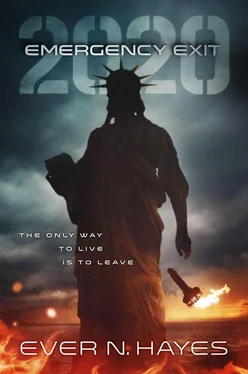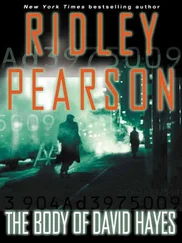As the tears running down my cheek began to compete with the raindrops on the window next to me, I wiped my eyes and tuned back in to Mom and Dad’s conversation up front. Dad was talking about how unexpected this was in America. How this is something you’d expect in the poor, hungry, and sick countries. And yet, he said, “We still should have seen it coming.” He was right. America had made an awful lot of enemies recently, but I never thought they could hit us like this.
Here we were, caught in a real-life reenactment of Red Dawn , that movie where the high school kids form a rebel band to combat against a West Coast invasion. But we weren’t looking for a fight. There was no one for us to save. And we didn’t get to just sit and hide. We had to run, right through the middle of those who wanted us dead, and towards the same place every American would be heading—if they’d also gotten the message. Like a herd of elephants crossing a thinly iced lake, we’d be hard to miss, and any misstep by one of us could be the last for all of us.
I couldn’t help but wonder what fate awaited us. If we did survive the trek across America, would Hawaii still be a safe zone? And even if it was, how long could we possibly live there, cut off from the rest of the world? What were we even supposed to hope for at this point? What were realistic expectations? I had absolutely no idea.
Hope is a loaded word. It can keep you going when you have it, or stop you dead in your tracks when you lose it. Trust me . The hardest part is persevering when it seems all hope is lost. I had a feeling we’d be testing our resolve on this trip. Probably more than once.
It was a little less than three hundred miles to Cabela’s from the cabin, about seven to eight hours at this pace. I turned my attention back to the darkness outside. The whole situation defied explanation. I couldn’t imagine how the entire attack had been carried out, or how far reaching the residual effects went. How many other survivors were out there, equally as bewildered and overwhelmed as we were?
After September 11, 2001, the military commanders of eight of the world’s most powerful militant countries met privately and discussed a joint venture to rid the world of America. Permanently. Counting on a full-scale retaliation for the Al Qaida attacks, and anticipating the superpower’s significant long-term distraction by that Middle East focus, these eight countries cemented their pact: China, North Korea, Russia, Cuba, Colombia, Mexico, Japan and Libya. (Cuba withdrew after their government collapsed in 2017.) Twelve years of planning, followed by six years of implementation, and only a single week of execution. They used America’s severe oil shortage and ensuing economic crisis to barter for what they needed to build and pull off a massive chemical and electromagnetic attack. “The Seven” created a new Russian car company, Lakaya, they wanted pushed in American markets. If the U.S. government promoted them on par with Ford, Chevy and Dodge, Russia would provide all the oil the U.S. needed. It was a no-brainer for U.S. politicians—lining their pockets and creating thousands of stateside transportation and dealership jobs—and served as a perfect Trojan horse for The Seven. Essentially, the U.S. financed its own demise.
Japanese and Russian chemical engineers manufactured automobile insulation packets for all Lakaya vehicles, with a deadly airborne contaminant strong enough to choke the oxygen out of any living being within seconds. The contaminant became lethal only when combined with the compound encapsulated in the detonators, which were packed securely inside the steering column of every vehicle. An accident, no matter how severe wouldn’t crack the compound capsule or mix the chemicals. The capsules could only be opened and detonated remotely, with a shared code, from a mainframe far away. When detonated, the airbags served as the propellant for the mixing and initial distribution of chemicals. Small vehicles were packed for small towns. Bigger vehicles were prepared for bigger towns and cities. Specific model distribution was organized accordingly. Ultimately, the bigger the vehicle, the greater the resulting contamination zone. A motorcycle could kill everything within two miles. A bus could expand that range tenfold. Airplanes could cover one hundred miles, easily, but they were only used at a dozen locations, the eleven largest mainland airports and one in Hawaii. The Federal Aviation Administration’s constant inspections made chemically packed airplanes too risky to mass-produce and distribute. Their placement was far riskier and had to be coordinated the exact week of the attack.
Vehicles, on the other hand, were mass produced in China, packed and branded in Russia, and stocked in Asian ports until the planning stage was complete. They were then shipped to, and distributed throughout, the United States. Grateful for the economic assistance, the U.S. opened its ports for the next several years to freighter after freighter of these automobiles with a blind eye towards inspections. Lakaya, as promised, became extremely in demand to American consumers, and over a million of them were quickly scattered across America, thousands in every state.
The Seven took no chances, however. Operatives specifically parked an additional twenty thousand vehicles in key locations across North America, in both the United States and Canada. In doing so, The Seven managed to get a bomb within five miles of every operable airport and occupied residential area of fifty thousand or more nationwide, military zone or civilian, without so much as a whiff of suspicion. It was impossible to cover every square mile, of course, but they were sure going to try.
Six hundred thousand chemical car bombs went off in silence just after 1AM Eastern Time, on October 13, catching and killing nearly half of all North Americans in their beds. Pedestrians collapsed wherever they stood, gasping for clean air and finding none. Others heading to or from home at that time died through vented exposure in their cars, crashing randomly throughout the affected zones. The chemicals contaminated water supplies and killed off all proximate human and animal life forms within each lethal distribution radius. Beyond the people living and working within those immediate impact zones, another ten percent of the population merely traveling through those areas, (by train, plane or automobile) within the forty-eight-hour toxic window also died.
The second wave of chemical bombs came two days later, in the form of another half million chemical car bombs, wiping out most of the remaining survivors, spreading even wider contamination, and taking immeasurable tolls on all remaining life.
The only physically destructive wave was the third one, as hundreds of planes flew over the major cities, scanning for survivors and bombing select targets. Since few Americans remained at this point, there were by far the least casualties in this wave. And since The Seven were intent on preserving the majority of America’s infrastructure for their own use, the destruction was intentionally limited.
SIX: “America’s Response”
As anticipated, America fought back at the onset of the first wave. As much as it could, that is, with only a feeble, domestic leg left to stand on. The nation’s nuclear arsenal had been programmed for instant retaliation—on a country-by-country basis and/or global—with all intended targets largely incapable of defending themselves, missile for missile, against America’s retaliatory launch. Military bases across the United States sounded their alarms and scrambled to secure themselves, but it was too late. Within minutes almost all the bases in America were silent.
Читать дальше












